Exit Project in International Law: Refugee Rights and Challenges
VerifiedAdded on 2020/05/28
|37
|10226
|149
Project
AI Summary
This project is an in-depth exploration of international law concerning refugees, asylum seekers, and internally displaced persons. It begins with an introduction to the topic, background information, and the rationale behind the research, emphasizing the historical context of refugee movements and the legal protections afforded by international human rights law. The project outlines the aims, objectives, and research questions, followed by a discussion of the methodology used. The core of the project delves into main discussions, including issues experienced by refugees, and an overview of the Statute of the International Criminal Court. The project highlights the importance of international cooperation and the legal frameworks designed to safeguard the rights of refugees and asylum seekers, referencing key documents like the 1951 Refugee Convention and the Universal Declaration of Human Rights. The project concludes with a summary of the findings, recommendations, and conclusions, emphasizing the need to respect the rights and dignity of refugees and the importance of international collaboration to address the challenges faced by displaced populations.
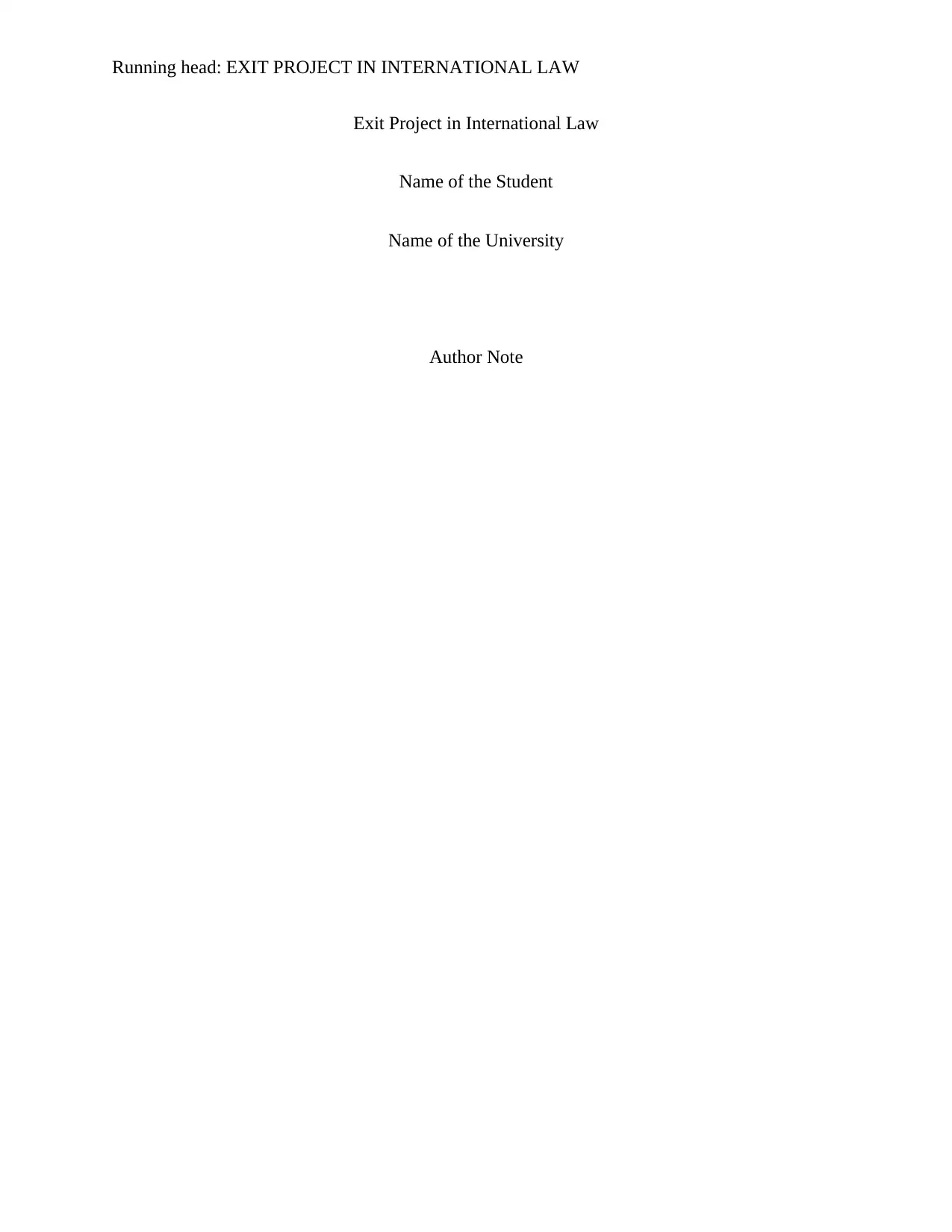
Running head: EXIT PROJECT IN INTERNATIONAL LAW
Exit Project in International Law
Name of the Student
Name of the University
Author Note
Exit Project in International Law
Name of the Student
Name of the University
Author Note
Paraphrase This Document
Need a fresh take? Get an instant paraphrase of this document with our AI Paraphraser
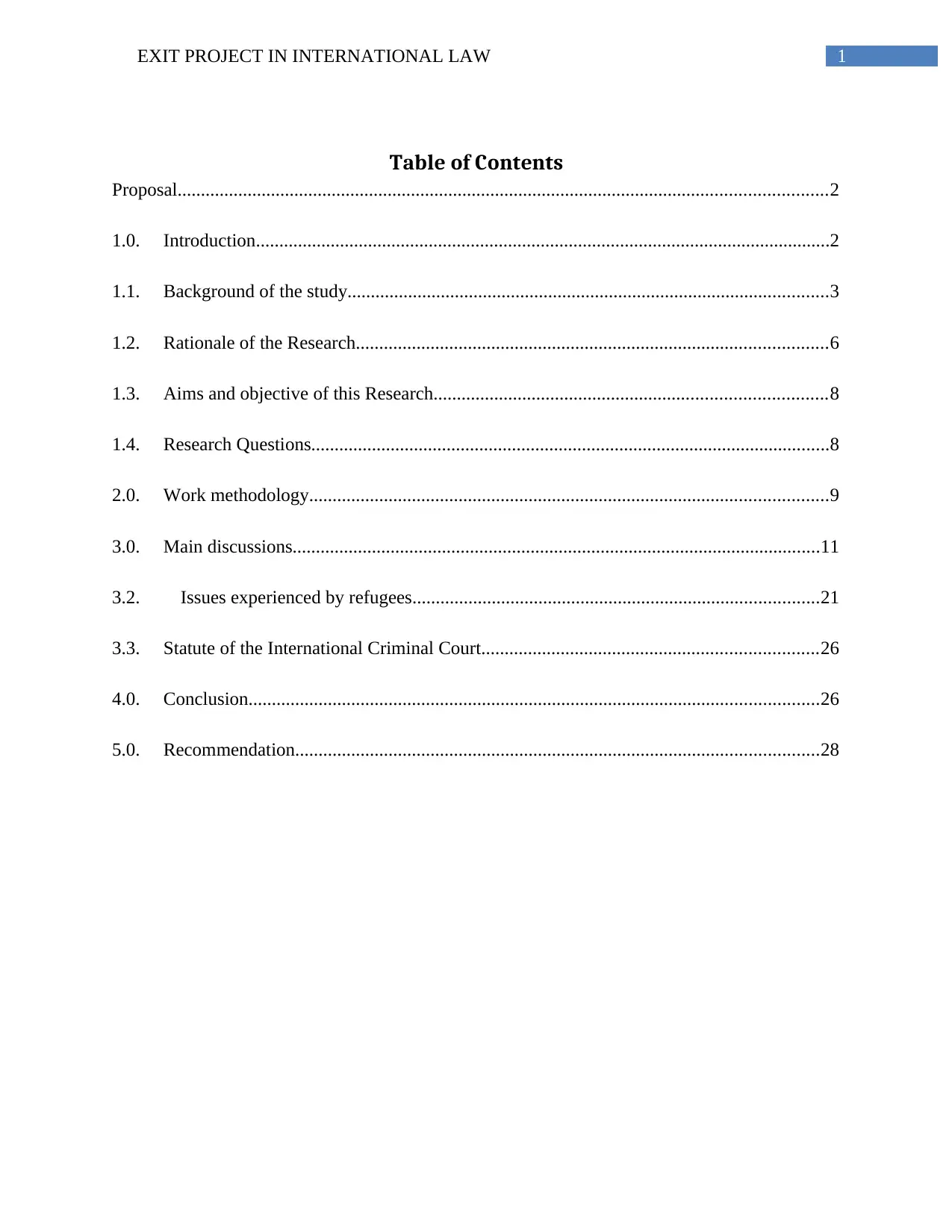
1EXIT PROJECT IN INTERNATIONAL LAW
Table of Contents
Proposal...........................................................................................................................................2
1.0. Introduction...........................................................................................................................2
1.1. Background of the study.......................................................................................................3
1.2. Rationale of the Research.....................................................................................................6
1.3. Aims and objective of this Research....................................................................................8
1.4. Research Questions...............................................................................................................8
2.0. Work methodology...............................................................................................................9
3.0. Main discussions.................................................................................................................11
3.2. Issues experienced by refugees.......................................................................................21
3.3. Statute of the International Criminal Court........................................................................26
4.0. Conclusion..........................................................................................................................26
5.0. Recommendation................................................................................................................28
Table of Contents
Proposal...........................................................................................................................................2
1.0. Introduction...........................................................................................................................2
1.1. Background of the study.......................................................................................................3
1.2. Rationale of the Research.....................................................................................................6
1.3. Aims and objective of this Research....................................................................................8
1.4. Research Questions...............................................................................................................8
2.0. Work methodology...............................................................................................................9
3.0. Main discussions.................................................................................................................11
3.2. Issues experienced by refugees.......................................................................................21
3.3. Statute of the International Criminal Court........................................................................26
4.0. Conclusion..........................................................................................................................26
5.0. Recommendation................................................................................................................28
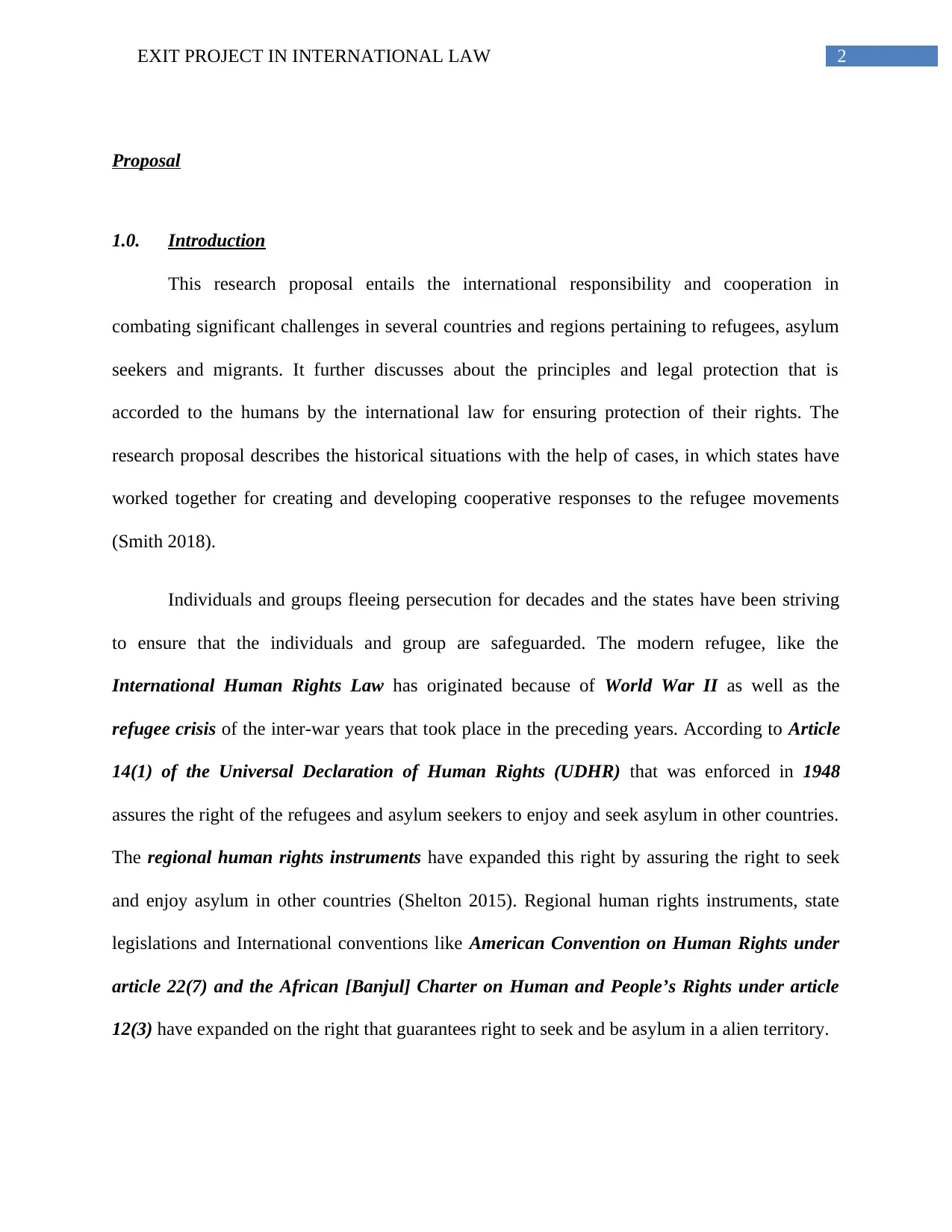
2EXIT PROJECT IN INTERNATIONAL LAW
Proposal
1.0. Introduction
This research proposal entails the international responsibility and cooperation in
combating significant challenges in several countries and regions pertaining to refugees, asylum
seekers and migrants. It further discusses about the principles and legal protection that is
accorded to the humans by the international law for ensuring protection of their rights. The
research proposal describes the historical situations with the help of cases, in which states have
worked together for creating and developing cooperative responses to the refugee movements
(Smith 2018).
Individuals and groups fleeing persecution for decades and the states have been striving
to ensure that the individuals and group are safeguarded. The modern refugee, like the
International Human Rights Law has originated because of World War II as well as the
refugee crisis of the inter-war years that took place in the preceding years. According to Article
14(1) of the Universal Declaration of Human Rights (UDHR) that was enforced in 1948
assures the right of the refugees and asylum seekers to enjoy and seek asylum in other countries.
The regional human rights instruments have expanded this right by assuring the right to seek
and enjoy asylum in other countries (Shelton 2015). Regional human rights instruments, state
legislations and International conventions like American Convention on Human Rights under
article 22(7) and the African [Banjul] Charter on Human and People’s Rights under article
12(3) have expanded on the right that guarantees right to seek and be asylum in a alien territory.
Proposal
1.0. Introduction
This research proposal entails the international responsibility and cooperation in
combating significant challenges in several countries and regions pertaining to refugees, asylum
seekers and migrants. It further discusses about the principles and legal protection that is
accorded to the humans by the international law for ensuring protection of their rights. The
research proposal describes the historical situations with the help of cases, in which states have
worked together for creating and developing cooperative responses to the refugee movements
(Smith 2018).
Individuals and groups fleeing persecution for decades and the states have been striving
to ensure that the individuals and group are safeguarded. The modern refugee, like the
International Human Rights Law has originated because of World War II as well as the
refugee crisis of the inter-war years that took place in the preceding years. According to Article
14(1) of the Universal Declaration of Human Rights (UDHR) that was enforced in 1948
assures the right of the refugees and asylum seekers to enjoy and seek asylum in other countries.
The regional human rights instruments have expanded this right by assuring the right to seek
and enjoy asylum in other countries (Shelton 2015). Regional human rights instruments, state
legislations and International conventions like American Convention on Human Rights under
article 22(7) and the African [Banjul] Charter on Human and People’s Rights under article
12(3) have expanded on the right that guarantees right to seek and be asylum in a alien territory.
⊘ This is a preview!⊘
Do you want full access?
Subscribe today to unlock all pages.

Trusted by 1+ million students worldwide
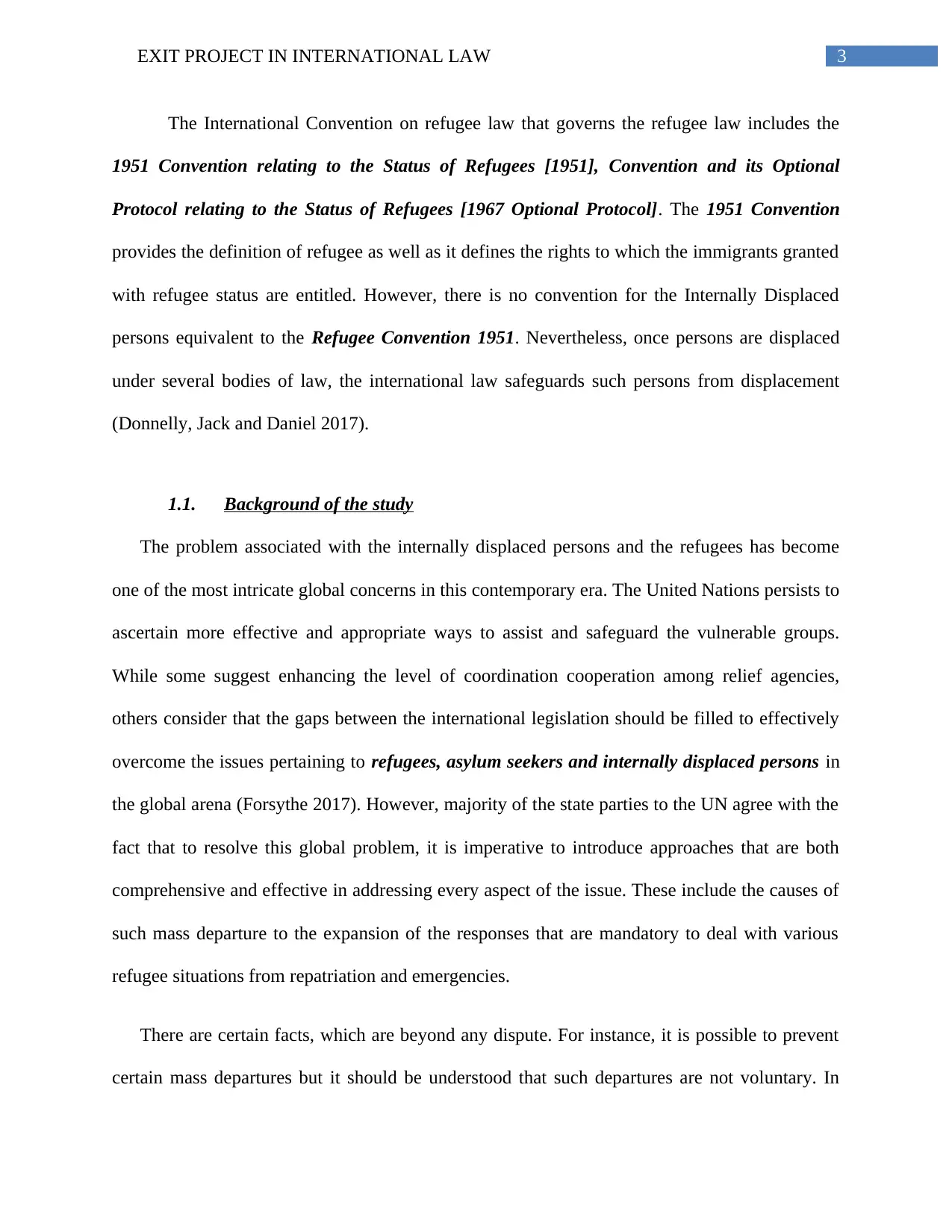
3EXIT PROJECT IN INTERNATIONAL LAW
The International Convention on refugee law that governs the refugee law includes the
1951 Convention relating to the Status of Refugees [1951], Convention and its Optional
Protocol relating to the Status of Refugees [1967 Optional Protocol]. The 1951 Convention
provides the definition of refugee as well as it defines the rights to which the immigrants granted
with refugee status are entitled. However, there is no convention for the Internally Displaced
persons equivalent to the Refugee Convention 1951. Nevertheless, once persons are displaced
under several bodies of law, the international law safeguards such persons from displacement
(Donnelly, Jack and Daniel 2017).
1.1. Background of the study
The problem associated with the internally displaced persons and the refugees has become
one of the most intricate global concerns in this contemporary era. The United Nations persists to
ascertain more effective and appropriate ways to assist and safeguard the vulnerable groups.
While some suggest enhancing the level of coordination cooperation among relief agencies,
others consider that the gaps between the international legislation should be filled to effectively
overcome the issues pertaining to refugees, asylum seekers and internally displaced persons in
the global arena (Forsythe 2017). However, majority of the state parties to the UN agree with the
fact that to resolve this global problem, it is imperative to introduce approaches that are both
comprehensive and effective in addressing every aspect of the issue. These include the causes of
such mass departure to the expansion of the responses that are mandatory to deal with various
refugee situations from repatriation and emergencies.
There are certain facts, which are beyond any dispute. For instance, it is possible to prevent
certain mass departures but it should be understood that such departures are not voluntary. In
The International Convention on refugee law that governs the refugee law includes the
1951 Convention relating to the Status of Refugees [1951], Convention and its Optional
Protocol relating to the Status of Refugees [1967 Optional Protocol]. The 1951 Convention
provides the definition of refugee as well as it defines the rights to which the immigrants granted
with refugee status are entitled. However, there is no convention for the Internally Displaced
persons equivalent to the Refugee Convention 1951. Nevertheless, once persons are displaced
under several bodies of law, the international law safeguards such persons from displacement
(Donnelly, Jack and Daniel 2017).
1.1. Background of the study
The problem associated with the internally displaced persons and the refugees has become
one of the most intricate global concerns in this contemporary era. The United Nations persists to
ascertain more effective and appropriate ways to assist and safeguard the vulnerable groups.
While some suggest enhancing the level of coordination cooperation among relief agencies,
others consider that the gaps between the international legislation should be filled to effectively
overcome the issues pertaining to refugees, asylum seekers and internally displaced persons in
the global arena (Forsythe 2017). However, majority of the state parties to the UN agree with the
fact that to resolve this global problem, it is imperative to introduce approaches that are both
comprehensive and effective in addressing every aspect of the issue. These include the causes of
such mass departure to the expansion of the responses that are mandatory to deal with various
refugee situations from repatriation and emergencies.
There are certain facts, which are beyond any dispute. For instance, it is possible to prevent
certain mass departures but it should be understood that such departures are not voluntary. In
Paraphrase This Document
Need a fresh take? Get an instant paraphrase of this document with our AI Paraphraser
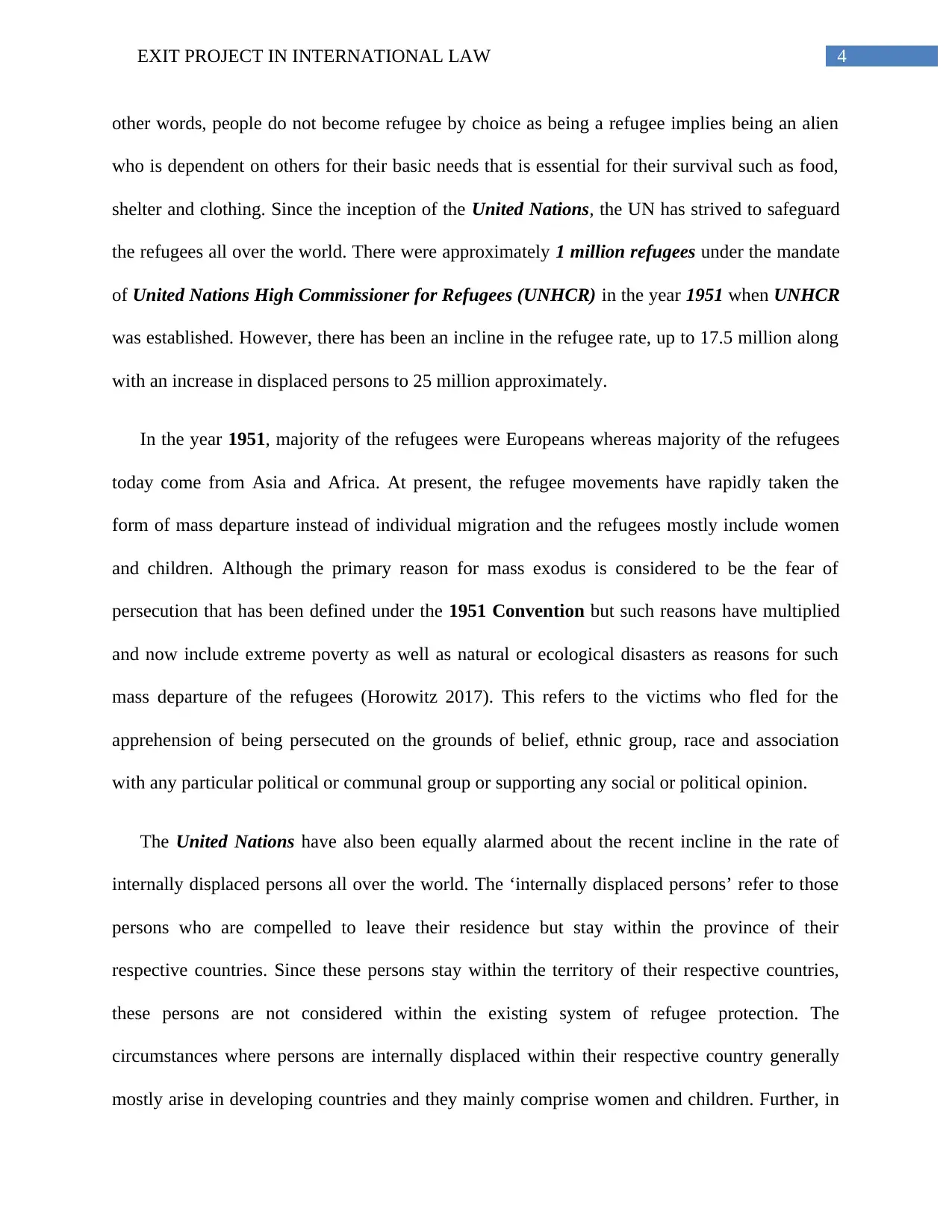
4EXIT PROJECT IN INTERNATIONAL LAW
other words, people do not become refugee by choice as being a refugee implies being an alien
who is dependent on others for their basic needs that is essential for their survival such as food,
shelter and clothing. Since the inception of the United Nations, the UN has strived to safeguard
the refugees all over the world. There were approximately 1 million refugees under the mandate
of United Nations High Commissioner for Refugees (UNHCR) in the year 1951 when UNHCR
was established. However, there has been an incline in the refugee rate, up to 17.5 million along
with an increase in displaced persons to 25 million approximately.
In the year 1951, majority of the refugees were Europeans whereas majority of the refugees
today come from Asia and Africa. At present, the refugee movements have rapidly taken the
form of mass departure instead of individual migration and the refugees mostly include women
and children. Although the primary reason for mass exodus is considered to be the fear of
persecution that has been defined under the 1951 Convention but such reasons have multiplied
and now include extreme poverty as well as natural or ecological disasters as reasons for such
mass departure of the refugees (Horowitz 2017). This refers to the victims who fled for the
apprehension of being persecuted on the grounds of belief, ethnic group, race and association
with any particular political or communal group or supporting any social or political opinion.
The United Nations have also been equally alarmed about the recent incline in the rate of
internally displaced persons all over the world. The ‘internally displaced persons’ refer to those
persons who are compelled to leave their residence but stay within the province of their
respective countries. Since these persons stay within the territory of their respective countries,
these persons are not considered within the existing system of refugee protection. The
circumstances where persons are internally displaced within their respective country generally
mostly arise in developing countries and they mainly comprise women and children. Further, in
other words, people do not become refugee by choice as being a refugee implies being an alien
who is dependent on others for their basic needs that is essential for their survival such as food,
shelter and clothing. Since the inception of the United Nations, the UN has strived to safeguard
the refugees all over the world. There were approximately 1 million refugees under the mandate
of United Nations High Commissioner for Refugees (UNHCR) in the year 1951 when UNHCR
was established. However, there has been an incline in the refugee rate, up to 17.5 million along
with an increase in displaced persons to 25 million approximately.
In the year 1951, majority of the refugees were Europeans whereas majority of the refugees
today come from Asia and Africa. At present, the refugee movements have rapidly taken the
form of mass departure instead of individual migration and the refugees mostly include women
and children. Although the primary reason for mass exodus is considered to be the fear of
persecution that has been defined under the 1951 Convention but such reasons have multiplied
and now include extreme poverty as well as natural or ecological disasters as reasons for such
mass departure of the refugees (Horowitz 2017). This refers to the victims who fled for the
apprehension of being persecuted on the grounds of belief, ethnic group, race and association
with any particular political or communal group or supporting any social or political opinion.
The United Nations have also been equally alarmed about the recent incline in the rate of
internally displaced persons all over the world. The ‘internally displaced persons’ refer to those
persons who are compelled to leave their residence but stay within the province of their
respective countries. Since these persons stay within the territory of their respective countries,
these persons are not considered within the existing system of refugee protection. The
circumstances where persons are internally displaced within their respective country generally
mostly arise in developing countries and they mainly comprise women and children. Further, in
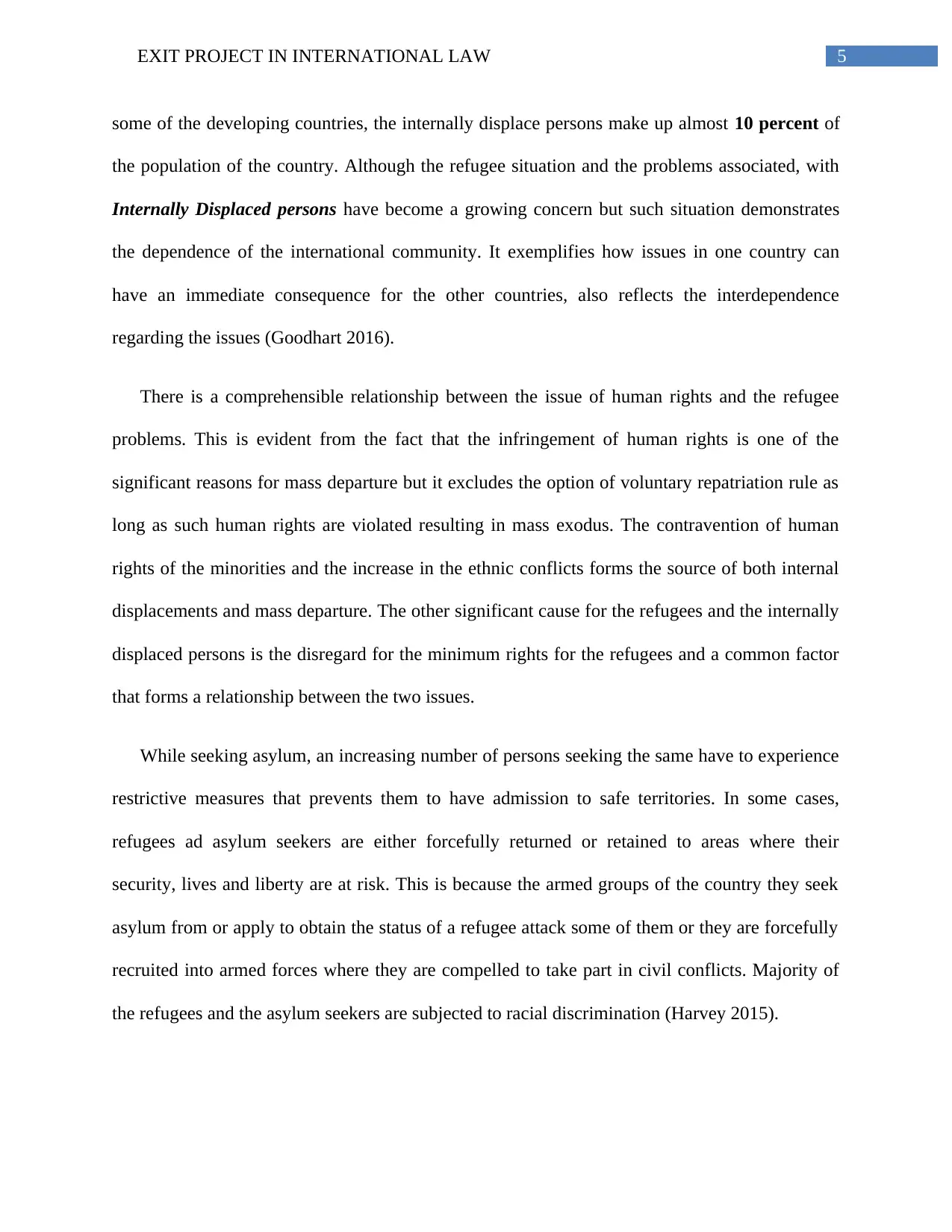
5EXIT PROJECT IN INTERNATIONAL LAW
some of the developing countries, the internally displace persons make up almost 10 percent of
the population of the country. Although the refugee situation and the problems associated, with
Internally Displaced persons have become a growing concern but such situation demonstrates
the dependence of the international community. It exemplifies how issues in one country can
have an immediate consequence for the other countries, also reflects the interdependence
regarding the issues (Goodhart 2016).
There is a comprehensible relationship between the issue of human rights and the refugee
problems. This is evident from the fact that the infringement of human rights is one of the
significant reasons for mass departure but it excludes the option of voluntary repatriation rule as
long as such human rights are violated resulting in mass exodus. The contravention of human
rights of the minorities and the increase in the ethnic conflicts forms the source of both internal
displacements and mass departure. The other significant cause for the refugees and the internally
displaced persons is the disregard for the minimum rights for the refugees and a common factor
that forms a relationship between the two issues.
While seeking asylum, an increasing number of persons seeking the same have to experience
restrictive measures that prevents them to have admission to safe territories. In some cases,
refugees ad asylum seekers are either forcefully returned or retained to areas where their
security, lives and liberty are at risk. This is because the armed groups of the country they seek
asylum from or apply to obtain the status of a refugee attack some of them or they are forcefully
recruited into armed forces where they are compelled to take part in civil conflicts. Majority of
the refugees and the asylum seekers are subjected to racial discrimination (Harvey 2015).
some of the developing countries, the internally displace persons make up almost 10 percent of
the population of the country. Although the refugee situation and the problems associated, with
Internally Displaced persons have become a growing concern but such situation demonstrates
the dependence of the international community. It exemplifies how issues in one country can
have an immediate consequence for the other countries, also reflects the interdependence
regarding the issues (Goodhart 2016).
There is a comprehensible relationship between the issue of human rights and the refugee
problems. This is evident from the fact that the infringement of human rights is one of the
significant reasons for mass departure but it excludes the option of voluntary repatriation rule as
long as such human rights are violated resulting in mass exodus. The contravention of human
rights of the minorities and the increase in the ethnic conflicts forms the source of both internal
displacements and mass departure. The other significant cause for the refugees and the internally
displaced persons is the disregard for the minimum rights for the refugees and a common factor
that forms a relationship between the two issues.
While seeking asylum, an increasing number of persons seeking the same have to experience
restrictive measures that prevents them to have admission to safe territories. In some cases,
refugees ad asylum seekers are either forcefully returned or retained to areas where their
security, lives and liberty are at risk. This is because the armed groups of the country they seek
asylum from or apply to obtain the status of a refugee attack some of them or they are forcefully
recruited into armed forces where they are compelled to take part in civil conflicts. Majority of
the refugees and the asylum seekers are subjected to racial discrimination (Harvey 2015).
⊘ This is a preview!⊘
Do you want full access?
Subscribe today to unlock all pages.

Trusted by 1+ million students worldwide
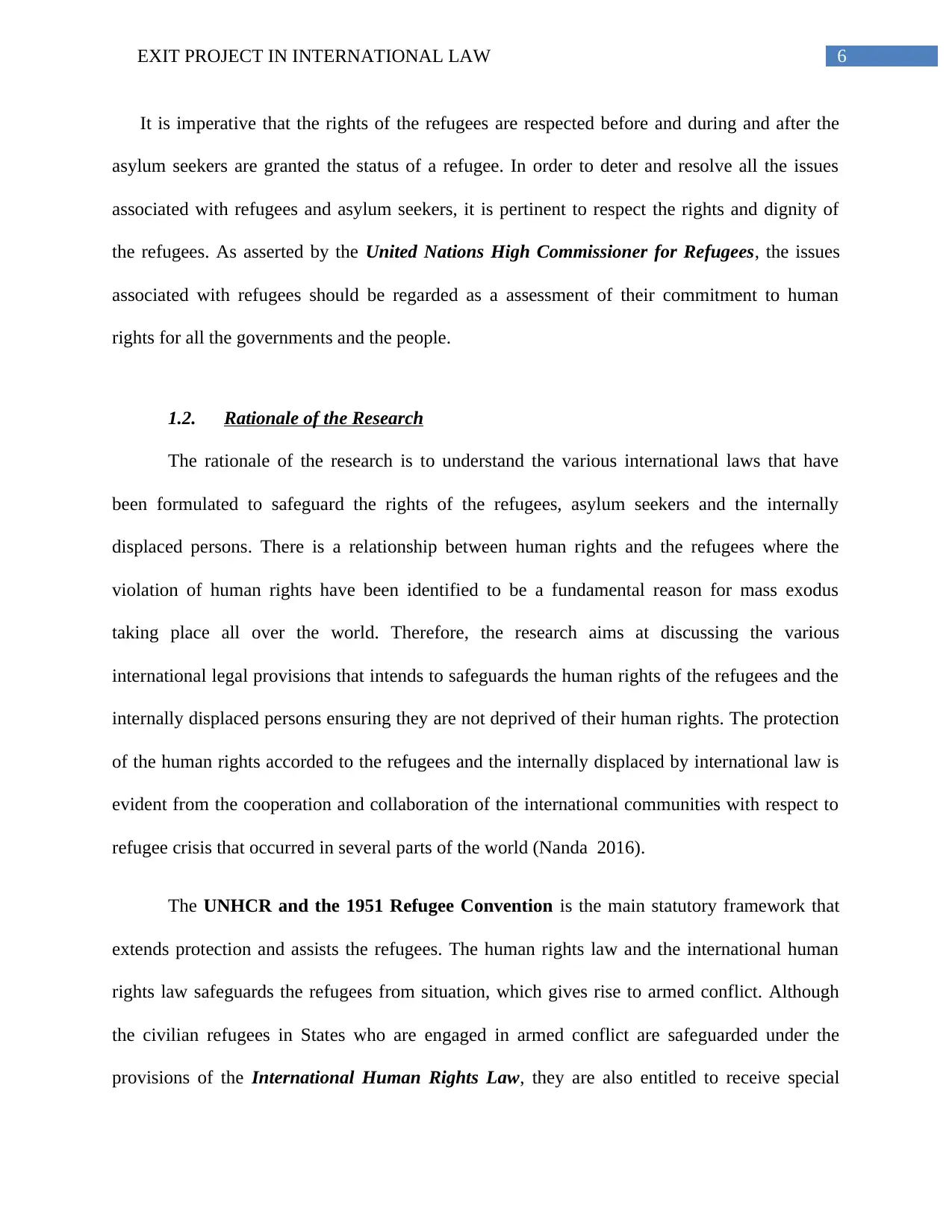
6EXIT PROJECT IN INTERNATIONAL LAW
It is imperative that the rights of the refugees are respected before and during and after the
asylum seekers are granted the status of a refugee. In order to deter and resolve all the issues
associated with refugees and asylum seekers, it is pertinent to respect the rights and dignity of
the refugees. As asserted by the United Nations High Commissioner for Refugees, the issues
associated with refugees should be regarded as a assessment of their commitment to human
rights for all the governments and the people.
1.2. Rationale of the Research
The rationale of the research is to understand the various international laws that have
been formulated to safeguard the rights of the refugees, asylum seekers and the internally
displaced persons. There is a relationship between human rights and the refugees where the
violation of human rights have been identified to be a fundamental reason for mass exodus
taking place all over the world. Therefore, the research aims at discussing the various
international legal provisions that intends to safeguards the human rights of the refugees and the
internally displaced persons ensuring they are not deprived of their human rights. The protection
of the human rights accorded to the refugees and the internally displaced by international law is
evident from the cooperation and collaboration of the international communities with respect to
refugee crisis that occurred in several parts of the world (Nanda 2016).
The UNHCR and the 1951 Refugee Convention is the main statutory framework that
extends protection and assists the refugees. The human rights law and the international human
rights law safeguards the refugees from situation, which gives rise to armed conflict. Although
the civilian refugees in States who are engaged in armed conflict are safeguarded under the
provisions of the International Human Rights Law, they are also entitled to receive special
It is imperative that the rights of the refugees are respected before and during and after the
asylum seekers are granted the status of a refugee. In order to deter and resolve all the issues
associated with refugees and asylum seekers, it is pertinent to respect the rights and dignity of
the refugees. As asserted by the United Nations High Commissioner for Refugees, the issues
associated with refugees should be regarded as a assessment of their commitment to human
rights for all the governments and the people.
1.2. Rationale of the Research
The rationale of the research is to understand the various international laws that have
been formulated to safeguard the rights of the refugees, asylum seekers and the internally
displaced persons. There is a relationship between human rights and the refugees where the
violation of human rights have been identified to be a fundamental reason for mass exodus
taking place all over the world. Therefore, the research aims at discussing the various
international legal provisions that intends to safeguards the human rights of the refugees and the
internally displaced persons ensuring they are not deprived of their human rights. The protection
of the human rights accorded to the refugees and the internally displaced by international law is
evident from the cooperation and collaboration of the international communities with respect to
refugee crisis that occurred in several parts of the world (Nanda 2016).
The UNHCR and the 1951 Refugee Convention is the main statutory framework that
extends protection and assists the refugees. The human rights law and the international human
rights law safeguards the refugees from situation, which gives rise to armed conflict. Although
the civilian refugees in States who are engaged in armed conflict are safeguarded under the
provisions of the International Human Rights Law, they are also entitled to receive special
Paraphrase This Document
Need a fresh take? Get an instant paraphrase of this document with our AI Paraphraser
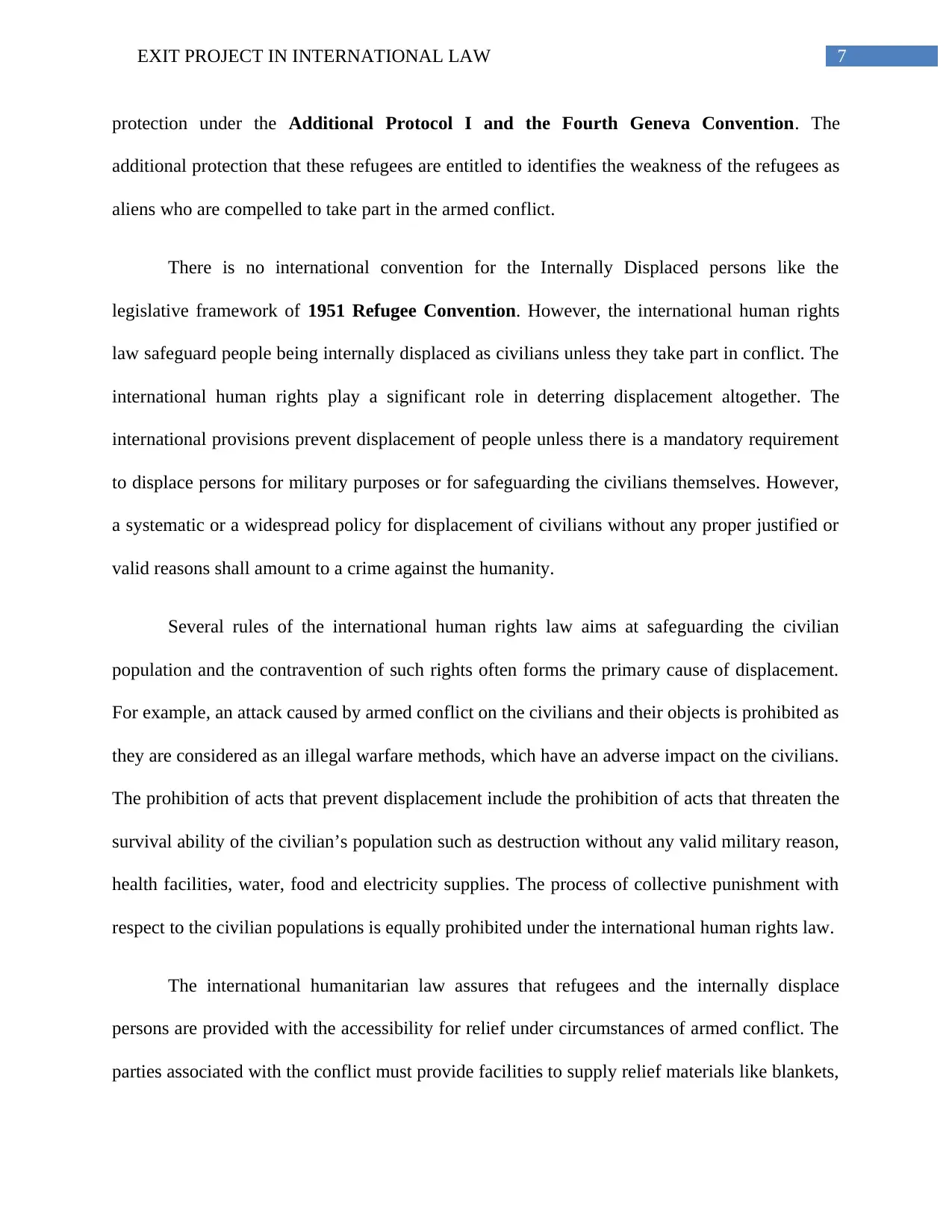
7EXIT PROJECT IN INTERNATIONAL LAW
protection under the Additional Protocol I and the Fourth Geneva Convention. The
additional protection that these refugees are entitled to identifies the weakness of the refugees as
aliens who are compelled to take part in the armed conflict.
There is no international convention for the Internally Displaced persons like the
legislative framework of 1951 Refugee Convention. However, the international human rights
law safeguard people being internally displaced as civilians unless they take part in conflict. The
international human rights play a significant role in deterring displacement altogether. The
international provisions prevent displacement of people unless there is a mandatory requirement
to displace persons for military purposes or for safeguarding the civilians themselves. However,
a systematic or a widespread policy for displacement of civilians without any proper justified or
valid reasons shall amount to a crime against the humanity.
Several rules of the international human rights law aims at safeguarding the civilian
population and the contravention of such rights often forms the primary cause of displacement.
For example, an attack caused by armed conflict on the civilians and their objects is prohibited as
they are considered as an illegal warfare methods, which have an adverse impact on the civilians.
The prohibition of acts that prevent displacement include the prohibition of acts that threaten the
survival ability of the civilian’s population such as destruction without any valid military reason,
health facilities, water, food and electricity supplies. The process of collective punishment with
respect to the civilian populations is equally prohibited under the international human rights law.
The international humanitarian law assures that refugees and the internally displace
persons are provided with the accessibility for relief under circumstances of armed conflict. The
parties associated with the conflict must provide facilities to supply relief materials like blankets,
protection under the Additional Protocol I and the Fourth Geneva Convention. The
additional protection that these refugees are entitled to identifies the weakness of the refugees as
aliens who are compelled to take part in the armed conflict.
There is no international convention for the Internally Displaced persons like the
legislative framework of 1951 Refugee Convention. However, the international human rights
law safeguard people being internally displaced as civilians unless they take part in conflict. The
international human rights play a significant role in deterring displacement altogether. The
international provisions prevent displacement of people unless there is a mandatory requirement
to displace persons for military purposes or for safeguarding the civilians themselves. However,
a systematic or a widespread policy for displacement of civilians without any proper justified or
valid reasons shall amount to a crime against the humanity.
Several rules of the international human rights law aims at safeguarding the civilian
population and the contravention of such rights often forms the primary cause of displacement.
For example, an attack caused by armed conflict on the civilians and their objects is prohibited as
they are considered as an illegal warfare methods, which have an adverse impact on the civilians.
The prohibition of acts that prevent displacement include the prohibition of acts that threaten the
survival ability of the civilian’s population such as destruction without any valid military reason,
health facilities, water, food and electricity supplies. The process of collective punishment with
respect to the civilian populations is equally prohibited under the international human rights law.
The international humanitarian law assures that refugees and the internally displace
persons are provided with the accessibility for relief under circumstances of armed conflict. The
parties associated with the conflict must provide facilities to supply relief materials like blankets,
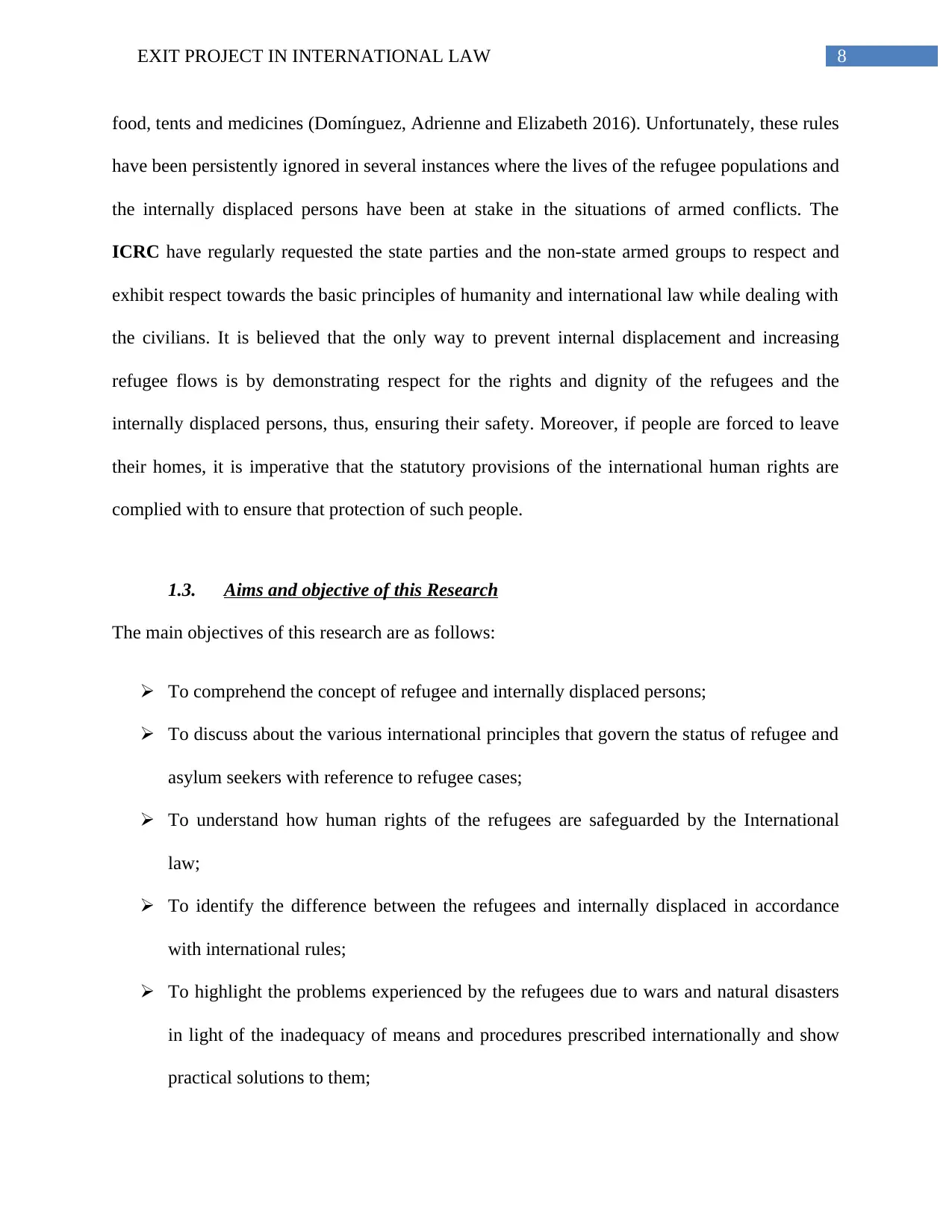
8EXIT PROJECT IN INTERNATIONAL LAW
food, tents and medicines (Domínguez, Adrienne and Elizabeth 2016). Unfortunately, these rules
have been persistently ignored in several instances where the lives of the refugee populations and
the internally displaced persons have been at stake in the situations of armed conflicts. The
ICRC have regularly requested the state parties and the non-state armed groups to respect and
exhibit respect towards the basic principles of humanity and international law while dealing with
the civilians. It is believed that the only way to prevent internal displacement and increasing
refugee flows is by demonstrating respect for the rights and dignity of the refugees and the
internally displaced persons, thus, ensuring their safety. Moreover, if people are forced to leave
their homes, it is imperative that the statutory provisions of the international human rights are
complied with to ensure that protection of such people.
1.3. Aims and objective of this Research
The main objectives of this research are as follows:
To comprehend the concept of refugee and internally displaced persons;
To discuss about the various international principles that govern the status of refugee and
asylum seekers with reference to refugee cases;
To understand how human rights of the refugees are safeguarded by the International
law;
To identify the difference between the refugees and internally displaced in accordance
with international rules;
To highlight the problems experienced by the refugees due to wars and natural disasters
in light of the inadequacy of means and procedures prescribed internationally and show
practical solutions to them;
food, tents and medicines (Domínguez, Adrienne and Elizabeth 2016). Unfortunately, these rules
have been persistently ignored in several instances where the lives of the refugee populations and
the internally displaced persons have been at stake in the situations of armed conflicts. The
ICRC have regularly requested the state parties and the non-state armed groups to respect and
exhibit respect towards the basic principles of humanity and international law while dealing with
the civilians. It is believed that the only way to prevent internal displacement and increasing
refugee flows is by demonstrating respect for the rights and dignity of the refugees and the
internally displaced persons, thus, ensuring their safety. Moreover, if people are forced to leave
their homes, it is imperative that the statutory provisions of the international human rights are
complied with to ensure that protection of such people.
1.3. Aims and objective of this Research
The main objectives of this research are as follows:
To comprehend the concept of refugee and internally displaced persons;
To discuss about the various international principles that govern the status of refugee and
asylum seekers with reference to refugee cases;
To understand how human rights of the refugees are safeguarded by the International
law;
To identify the difference between the refugees and internally displaced in accordance
with international rules;
To highlight the problems experienced by the refugees due to wars and natural disasters
in light of the inadequacy of means and procedures prescribed internationally and show
practical solutions to them;
⊘ This is a preview!⊘
Do you want full access?
Subscribe today to unlock all pages.

Trusted by 1+ million students worldwide
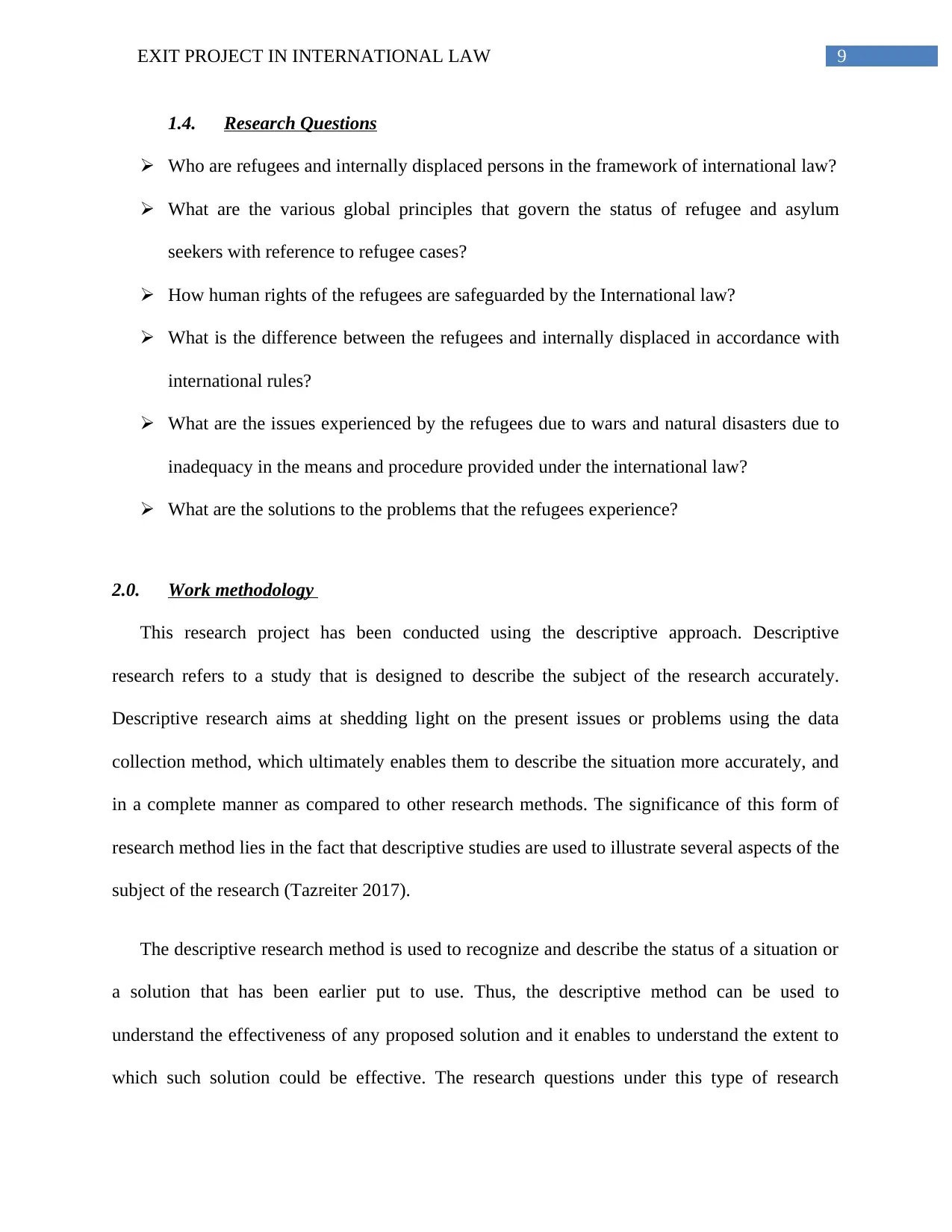
9EXIT PROJECT IN INTERNATIONAL LAW
1.4. Research Questions
Who are refugees and internally displaced persons in the framework of international law?
What are the various global principles that govern the status of refugee and asylum
seekers with reference to refugee cases?
How human rights of the refugees are safeguarded by the International law?
What is the difference between the refugees and internally displaced in accordance with
international rules?
What are the issues experienced by the refugees due to wars and natural disasters due to
inadequacy in the means and procedure provided under the international law?
What are the solutions to the problems that the refugees experience?
2.0. Work methodology
This research project has been conducted using the descriptive approach. Descriptive
research refers to a study that is designed to describe the subject of the research accurately.
Descriptive research aims at shedding light on the present issues or problems using the data
collection method, which ultimately enables them to describe the situation more accurately, and
in a complete manner as compared to other research methods. The significance of this form of
research method lies in the fact that descriptive studies are used to illustrate several aspects of the
subject of the research (Tazreiter 2017).
The descriptive research method is used to recognize and describe the status of a situation or
a solution that has been earlier put to use. Thus, the descriptive method can be used to
understand the effectiveness of any proposed solution and it enables to understand the extent to
which such solution could be effective. The research questions under this type of research
1.4. Research Questions
Who are refugees and internally displaced persons in the framework of international law?
What are the various global principles that govern the status of refugee and asylum
seekers with reference to refugee cases?
How human rights of the refugees are safeguarded by the International law?
What is the difference between the refugees and internally displaced in accordance with
international rules?
What are the issues experienced by the refugees due to wars and natural disasters due to
inadequacy in the means and procedure provided under the international law?
What are the solutions to the problems that the refugees experience?
2.0. Work methodology
This research project has been conducted using the descriptive approach. Descriptive
research refers to a study that is designed to describe the subject of the research accurately.
Descriptive research aims at shedding light on the present issues or problems using the data
collection method, which ultimately enables them to describe the situation more accurately, and
in a complete manner as compared to other research methods. The significance of this form of
research method lies in the fact that descriptive studies are used to illustrate several aspects of the
subject of the research (Tazreiter 2017).
The descriptive research method is used to recognize and describe the status of a situation or
a solution that has been earlier put to use. Thus, the descriptive method can be used to
understand the effectiveness of any proposed solution and it enables to understand the extent to
which such solution could be effective. The research questions under this type of research
Paraphrase This Document
Need a fresh take? Get an instant paraphrase of this document with our AI Paraphraser
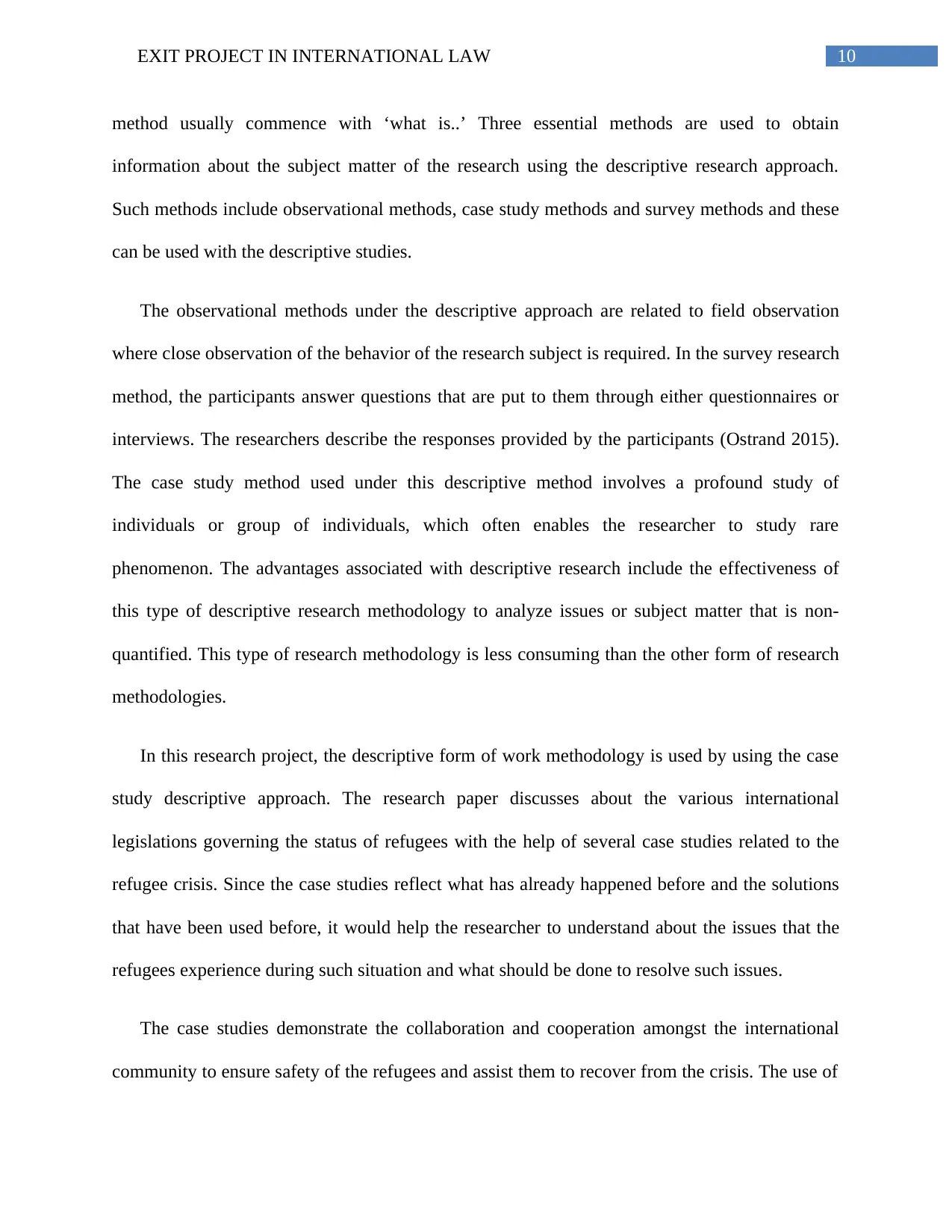
10EXIT PROJECT IN INTERNATIONAL LAW
method usually commence with ‘what is..’ Three essential methods are used to obtain
information about the subject matter of the research using the descriptive research approach.
Such methods include observational methods, case study methods and survey methods and these
can be used with the descriptive studies.
The observational methods under the descriptive approach are related to field observation
where close observation of the behavior of the research subject is required. In the survey research
method, the participants answer questions that are put to them through either questionnaires or
interviews. The researchers describe the responses provided by the participants (Ostrand 2015).
The case study method used under this descriptive method involves a profound study of
individuals or group of individuals, which often enables the researcher to study rare
phenomenon. The advantages associated with descriptive research include the effectiveness of
this type of descriptive research methodology to analyze issues or subject matter that is non-
quantified. This type of research methodology is less consuming than the other form of research
methodologies.
In this research project, the descriptive form of work methodology is used by using the case
study descriptive approach. The research paper discusses about the various international
legislations governing the status of refugees with the help of several case studies related to the
refugee crisis. Since the case studies reflect what has already happened before and the solutions
that have been used before, it would help the researcher to understand about the issues that the
refugees experience during such situation and what should be done to resolve such issues.
The case studies demonstrate the collaboration and cooperation amongst the international
community to ensure safety of the refugees and assist them to recover from the crisis. The use of
method usually commence with ‘what is..’ Three essential methods are used to obtain
information about the subject matter of the research using the descriptive research approach.
Such methods include observational methods, case study methods and survey methods and these
can be used with the descriptive studies.
The observational methods under the descriptive approach are related to field observation
where close observation of the behavior of the research subject is required. In the survey research
method, the participants answer questions that are put to them through either questionnaires or
interviews. The researchers describe the responses provided by the participants (Ostrand 2015).
The case study method used under this descriptive method involves a profound study of
individuals or group of individuals, which often enables the researcher to study rare
phenomenon. The advantages associated with descriptive research include the effectiveness of
this type of descriptive research methodology to analyze issues or subject matter that is non-
quantified. This type of research methodology is less consuming than the other form of research
methodologies.
In this research project, the descriptive form of work methodology is used by using the case
study descriptive approach. The research paper discusses about the various international
legislations governing the status of refugees with the help of several case studies related to the
refugee crisis. Since the case studies reflect what has already happened before and the solutions
that have been used before, it would help the researcher to understand about the issues that the
refugees experience during such situation and what should be done to resolve such issues.
The case studies demonstrate the collaboration and cooperation amongst the international
community to ensure safety of the refugees and assist them to recover from the crisis. The use of
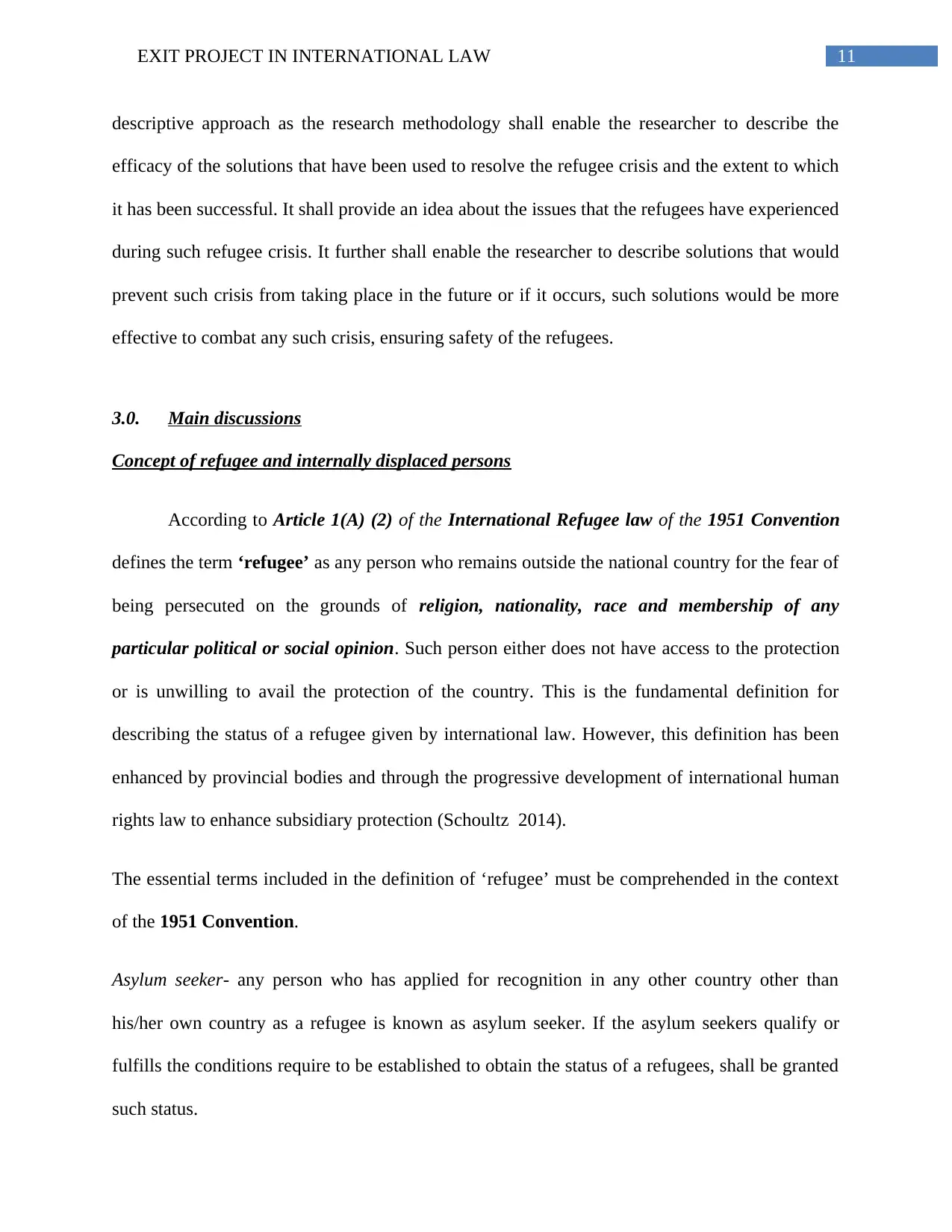
11EXIT PROJECT IN INTERNATIONAL LAW
descriptive approach as the research methodology shall enable the researcher to describe the
efficacy of the solutions that have been used to resolve the refugee crisis and the extent to which
it has been successful. It shall provide an idea about the issues that the refugees have experienced
during such refugee crisis. It further shall enable the researcher to describe solutions that would
prevent such crisis from taking place in the future or if it occurs, such solutions would be more
effective to combat any such crisis, ensuring safety of the refugees.
3.0. Main discussions
Concept of refugee and internally displaced persons
According to Article 1(A) (2) of the International Refugee law of the 1951 Convention
defines the term ‘refugee’ as any person who remains outside the national country for the fear of
being persecuted on the grounds of religion, nationality, race and membership of any
particular political or social opinion. Such person either does not have access to the protection
or is unwilling to avail the protection of the country. This is the fundamental definition for
describing the status of a refugee given by international law. However, this definition has been
enhanced by provincial bodies and through the progressive development of international human
rights law to enhance subsidiary protection (Schoultz 2014).
The essential terms included in the definition of ‘refugee’ must be comprehended in the context
of the 1951 Convention.
Asylum seeker- any person who has applied for recognition in any other country other than
his/her own country as a refugee is known as asylum seeker. If the asylum seekers qualify or
fulfills the conditions require to be established to obtain the status of a refugees, shall be granted
such status.
descriptive approach as the research methodology shall enable the researcher to describe the
efficacy of the solutions that have been used to resolve the refugee crisis and the extent to which
it has been successful. It shall provide an idea about the issues that the refugees have experienced
during such refugee crisis. It further shall enable the researcher to describe solutions that would
prevent such crisis from taking place in the future or if it occurs, such solutions would be more
effective to combat any such crisis, ensuring safety of the refugees.
3.0. Main discussions
Concept of refugee and internally displaced persons
According to Article 1(A) (2) of the International Refugee law of the 1951 Convention
defines the term ‘refugee’ as any person who remains outside the national country for the fear of
being persecuted on the grounds of religion, nationality, race and membership of any
particular political or social opinion. Such person either does not have access to the protection
or is unwilling to avail the protection of the country. This is the fundamental definition for
describing the status of a refugee given by international law. However, this definition has been
enhanced by provincial bodies and through the progressive development of international human
rights law to enhance subsidiary protection (Schoultz 2014).
The essential terms included in the definition of ‘refugee’ must be comprehended in the context
of the 1951 Convention.
Asylum seeker- any person who has applied for recognition in any other country other than
his/her own country as a refugee is known as asylum seeker. If the asylum seekers qualify or
fulfills the conditions require to be established to obtain the status of a refugees, shall be granted
such status.
⊘ This is a preview!⊘
Do you want full access?
Subscribe today to unlock all pages.

Trusted by 1+ million students worldwide
1 out of 37
Related Documents
Your All-in-One AI-Powered Toolkit for Academic Success.
+13062052269
info@desklib.com
Available 24*7 on WhatsApp / Email
![[object Object]](/_next/static/media/star-bottom.7253800d.svg)
Unlock your academic potential
Copyright © 2020–2025 A2Z Services. All Rights Reserved. Developed and managed by ZUCOL.





